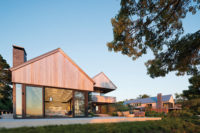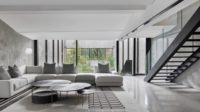Pentagram
Montauk, New York
Jim Biber, FAIA, worked with his clients for seven years on this residential compound on a ridge overlooking the Atlantic Ocean in Montauk, New York. But instead of being exhausted by the long process, with its delays in approvals and construction, everyone involved in the project readily admitted their love for design kept them motivated and engaged from start to finish. Biber, a partner at the international design firm Pentagram, has designed 12 projects for the clients, a couple, including this one. He describes the clients as more patrons than owners. They in turn have succinctly presented their point of view: “We could buy a Picasso, but this was a lot more fun.”
Inspiration for the project came from Midcentury Modernism, in particular the Case Study Houses program, run by Arts & Architecture magazine in the 1940s, ’50s, and ’60s.
At the beginning of the project in 1999, the architect and owners took a guided tour, organized by the Cooper-Hewitt, National Design Museum, of Modern postwar houses in Los Angeles and Palm Springs, California. The trip allowed them to expand their knowledge and develop a common vocabulary, which became the basis for communication during the design process.
The site created enormous challenges and opportunities. Working with two contiguous, 2-acre building lots with zoning and easement restrictions, and limitations imposed by the bluffs, the deep beach, and neighbors on both sides, the architect used the restraints to evolve the design gradually. “With the goal of a porous outdoor room, boundaries were developed over time. The impact of the main house became clear, and the neighbors built a house overlooking the property. Like a chess game, each move was a reaction to the previous one, with a big idea in mind,” explained project manager Michael Zweck-Bronner.
The low-slung, 7,192-square-foot main house consists of two back-to-back L-shaped sections: a glass-and-steel unit in the front containing the living, dining, and kitchen areas; and in the back, a more densely packed private wing with a master-bedroom/sitting-room suite and a guest suite. A tiny second-story study tops the house, and a full basement contains a screening room, gym, darkroom, and utility areas.
Across the courtyard, the architect raised the 2,475-square-foot guesthouse one story above ground and gave it a vibrant yellow circular outdoor stair.




Post a comment to this article
Report Abusive Comment